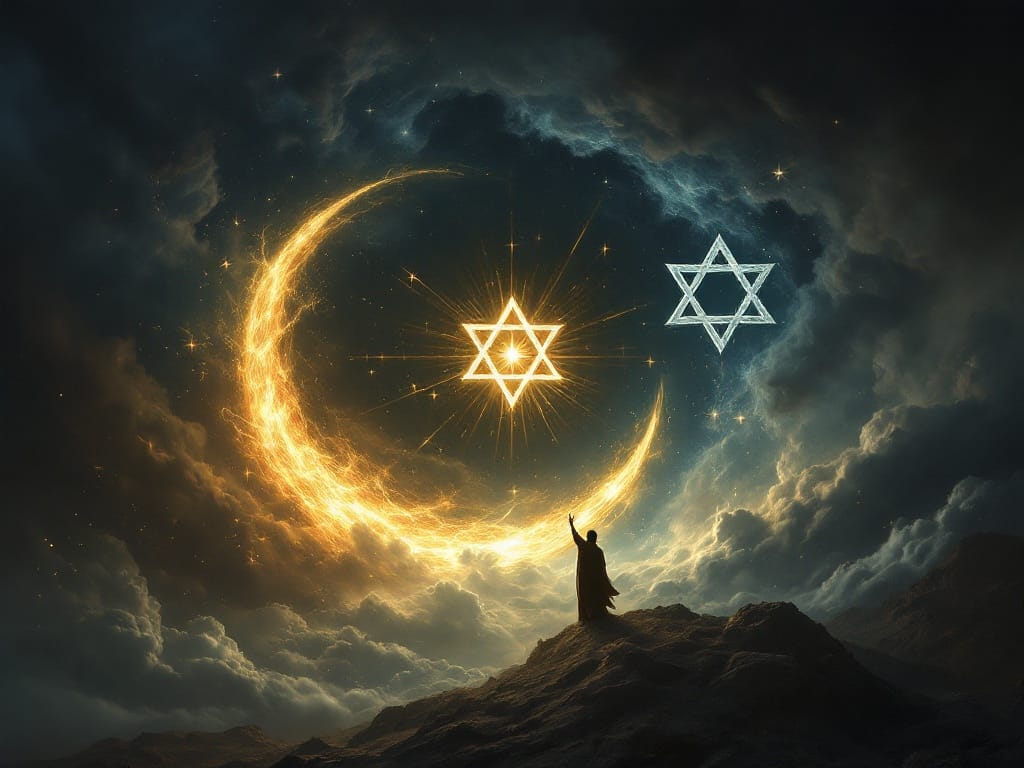

By Dr. Tim Orr
My journey into understanding Iran’s deep hostility toward Israel has been shaped by my time studying at the Islamic College in London, a Twelver Shia institution. Earning my MA in Islamic Studies there gave me a rare opportunity to study under Muslim scholars, engage with Shia theology, and explore the eschatological beliefs that drive much of Iran’s worldview. This experience wasn’t just academic—it gave me an insider’s understanding of how deeply religion, particularly Twelver Shia messianic theology, shapes the Iranian regime’s outlook.
What struck me most during my studies was realizing that Iran’s hatred for Israel is not just political—it’s theological. While many Western academics and politicians try to explain Iran’s aggression through politics, power struggles, or historical grievances, they miss the bigger picture. For Iran’s leadership, Israel’s destruction isn’t just a goal; it’s seen as a divine requirement—a step toward bringing about the return of the Mahdi, the Twelfth Imam. This isn’t something that can be fixed with diplomacy or appeasement, and it’s a reality that far too many in the West fail to grasp. My time at the Islamic College gave me the tools to connect these dots, and it’s a perspective that I believe the world urgently needs to hear.
Why Does Iran Hate Israel? The Answer Is Deeper Than Politics
When people try to explain Iran’s hostility toward Israel, they often look for easy answers—grievances over land, historical conflicts, or geopolitical competition. Western academics and politicians alike are quick to attribute Iran’s aggression to cause-and-effect reasoning—blaming sanctions, U.S. intervention, or regional power struggles. These explanations, though convenient, miss the mark entirely. They fail to acknowledge that Iran’s war against Israel is not a political struggle but a religious war rooted in Twelver Shia eschatology—a theology that exalts death, martyrdom, and the creation of chaos as a path to ushering in the end of the world (Lewis, 2002; Cook, 2005).
Unlike conventional conflicts, where diplomacy or deterrence can offer solutions, Iran’s aggression springs from a belief system that glorifies destruction as a necessary precursor to divine intervention. This is a regime that celebrates martyrdom, views bloodshed as sacred, and sees Israel’s existence as a spiritual affront that must be wiped out to fulfill apocalyptic prophecy (Taheri, 2009). To understand Iran’s motivations, one must move beyond secular frameworks and acknowledge that this is not about politics or borders. Iran’s leaders are driven by the conviction that they are carrying out a divine mission—one that demands Israel’s destruction as the gateway to a global Islamic order. Until the West grasps this theological dimension, its response to Iran will remain inadequate and dangerously naive.
A War of Theology, Not Politics: Understanding the Iranian Regime
Iran’s unrelenting hostility toward Israel cannot be reduced to mere geopolitics, economics, or regional rivalries. At the heart of Iran’s aggression lies a deeply entrenched apocalyptic vision tied to Twelver Shia Islam, the official ideology of the Islamic Republic (Nasr, 2006). This vision drives Iran’s leaders to wage a war not just against a state but against an entire theological symbol: Israel, the thriving Jewish democracy in the heart of the Muslim Middle East. For Iran, the destruction of Israel is not just a political goal but a divine requirement, a step toward fulfilling their eschatological destiny.
Iran’s leadership sees itself as divinely chosen to prepare the world for the return of the Mahdi, the Twelfth Imam, who will emerge to establish global justice (Halm, 1991). According to this belief, global chaos, bloodshed, and the defeat of perceived enemies—chiefly Israel—are necessary conditions for the Mahdi’s return. The regime’s actions, from funding terror groups to destabilizing neighboring countries, are therefore not simply pragmatic. They are sacred acts viewed as fulfilling divine prophecy. This theological foundation makes Iran’s aggression far more dangerous than conventional state conflict. It cannot be negotiated away or resolved through diplomacy because, to Iran, peace is not the goal—martyrdom and divine justice are.
The Hidden Imam: Iran’s Messianic Agenda
At the center of this eschatological vision is the Shia belief in the Twelfth Imam, also known as the Mahdi. According to Twelver Shia theology, the Mahdi is the final and ultimate savior who will emerge to restore divine justice and lead the world into an era of global Islamic dominance (Sachedina, 1981). Shia Muslims believe the Mahdi disappeared in the 9th century, entering a state of divine “occultation” (ghaybah). In this state, he remains hidden, preserved by God until the appointed time of his reappearance. For the Mahdi to return, however, the world must first descend into catastrophic chaos, a condition that Iran’s leaders actively seek to cultivate.
Iranian clerics preach that their role accelerates the Mahdi’s return by creating the conditions foretold in prophecy. Unlike other religious traditions where peace and harmony bring about salvation, Twelver Shia eschatology demands bloodshed, turmoil, and the defeat of Islam’s perceived enemies. In this narrative, Israel is the “obstacle” that delays the Mahdi’s reappearance (Khalaji, 2009). Iranian leaders amplify chilling beliefs, such as the claim that the Mahdi will not emerge until the “last drop of Jewish blood” is spilled. Though not rooted in the Quran, this narrative has been weaponized by the regime to mobilize its people and proxies in a relentless campaign against Israel.
Ayatollah Khomeini, the founder of the Islamic Republic, cemented Iran’s messianic role by declaring Iran as the “Vanguard of the Mahdi”—the nation tasked with preparing the world for his return. In Khomeini’s view, Iran’s revolution in 1979 was not merely a political upheaval but a cosmic event that placed Iran at the center of God’s plan. Today, this mantle has been carried forward by his successor, Ayatollah Ali Khamenei, who portrays Iran’s military forces and terror proxies as instruments for fulfilling divine prophecy. The Islamic Revolutionary Guard Corps (IRGC), Iran’s most powerful military body, views itself as the Mahdi’s army-in-waiting, working tirelessly to spread chaos and confront Israel, which they see as the embodiment of evil.
Israel as the Theological Obstacle to the Mahdi’s Return
To Iran’s leadership, Israel represents far more than a political adversary—it is a spiritual challenge that must be overcome to fulfill divine prophecy. Twelver Shia theology teaches that the Muslim world must achieve dominance under Islamic rule for the Mahdi to return (Lewis, 1986). The existence of a Jewish state in the land that was once under Islamic rule directly contradicts this theological vision. Israel’s thriving democracy, military strength, and cultural influence make it a glaring affront to the regime’s vision of Islamic supremacy.
Furthermore, Israel’s survival disrupts the eschatological timeline that Iran’s leaders are so committed to. In their view, the destruction of Israel is not optional—it is necessary. Every military strike, every terror attack, and every missile launched is aimed at eroding Israel’s resilience, setting the stage for its ultimate annihilation. By removing Israel, Iran believes it will remove the last major obstacle delaying the Mahdi’s reappearance. This is why Iran’s leaders have publicly declared their intent to “wipe Israel off the map” (Brumberg, 2001). Such statements are not political hyperbole; they are theological mandates embedded in their vision for the end of the world.
The Proxy Strategy: Creating Chaos to Fulfill Prophecy
Iran’s apocalyptic vision does not remain confined to theological rhetoric. It directly shapes the regime’s military strategy, particularly its reliance on proxy forces across the Middle East. Recognizing that Iran’s geographical distance limits its ability to attack Israel directly, the regime has methodically built a network of proxies to encircle and destabilize Israel from all sides. These proxies are not just tools of regional influence; they are instruments for creating chaos and bloodshed, fulfilling the conditions required for the Mahdi’s return.
Nuclear Weapons: Prophecy Meets Catastrophe
Perhaps the most chilling aspect of Iran’s eschatological vision is its pursuit of nuclear weapons. While most nations view nuclear arms as tools of deterrence, Iran sees them as instruments to fulfill divine prophecy. For the regime, the possession of nuclear weapons would provide the ultimate capability to destroy Israel and create the global chaos required for the Mahdi’s return.
Statements from Iranian leaders, such as Mahmoud Ahmadinejad’s declaration that Israel must be “wiped off the map,” are not political hyperbole. They are theological commitments rooted in their belief system. If Iran acquires nuclear weapons, the world will face a regime that sees mass destruction not as a threat but as a sacred act of obedience to God’s will.
Conclusion: Confronting Iran’s Apocalyptic Vision
Iran’s hatred of Israel cannot be reduced to politics or pragmatism. It is a theological war driven by a messianic vision that demands Israel’s destruction. Until the world acknowledges the religious ideology at the heart of Iran’s actions, any attempt to contain the regime will fail. This is not a conflict that can be resolved through appeasement or negotiation. An ideologicalideological struggle that demands moral clarity, strategic resolve, and a clear understanding of the stakes.
References
Brumberg, D. (2001). Reinventing Khomeini: The Struggle for Reform in Iran. University of Chicago Press.
Cook, D. (2005). Understanding Jihad. University of California Press.
Halm, H. (1991). Shi'a Islam: From Religion to Revolution. Markus Wiener Publishers.
Khalaji, M. (2009). Apocalyptic Politics: On the Rationality of Iranian Policy. The Washington Institute for Near East Policy.
Lewis, B. (1986). Semites and Anti-Semites: An Inquiry into Conflict and Prejudice. W.W. Norton.
Lewis, B. (2002). What Went Wrong? Western Impact and Middle Eastern Response. Oxford University Press.
Nasr, V. (2006). The Shia Revival: How Conflicts Within Islam Will Shape the Future. W.W. Norton.
Sachedina, A. (1981). Islamic Messianism: The Idea of the Mahdi in Twelver Shi'ism. State University of New York Press.
Taheri, A. (2009). The Persian Night: Iran Under the Khomeinist Revolution. Encounter Books.
Tim Orr is a scholar of Islam, Evangelical minister, conference speaker, and interfaith consultant with over 30 years of experience in cross-cultural ministry. He holds six degrees, including a master’s in Islamic studies from the Islamic College in London. Tim taught Religious Studies for 15 years at Indiana University Columbus and is now a Congregations and Polarization Project research associate at the Center for the Study of Religion and American Culture at Indiana University Indianapolis. He has spoken at universities, including Oxford University, Imperial College London, the University of Tehran, Islamic College London, and mosques throughout the U.K. His research focuses on American Evangelicalism, Islamic antisemitism, and Islamic feminism, and he has published widely, including articles in Islamic peer-reviewed journals and three books.
Sign up for Dr. Tim Orr's Blog
Dr. Tim Orr isn't just your average academic—he's a passionate advocate for interreligious dialogue, a seasoned academic, and an ordained Evangelical minister with a unique vision.
No spam. Unsubscribe anytime.
